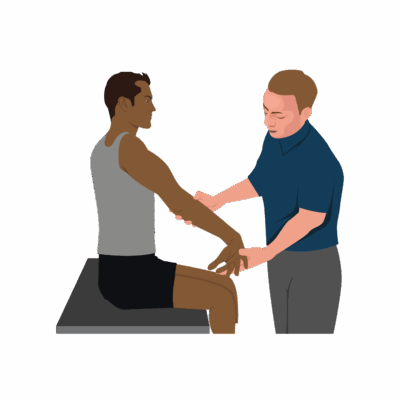Mill’s Test
Mill’s Test is an orthopedic examination used to diagnose lateral epicondylitis (tennis elbow) by maximally stretching the wrist extensor muscles (primarily the extensor carpi radialis longus and brevis) to provoke pain at their common tendon origin on the lateral epicondyle of the elbow.
How the Test is Performed
-
Client position: Seated or standing, arm relaxed.
-
The therapist palpates the lateral epicondyle of the client’s elbow.
-
The therapist then passively pronates the forearm, flexes the wrist, and extends the elbow simultaneously, while maintaining this stretch.
-
Positive Test: Sudden, localized pain at the lateral epicondyle during the maneuver.
-
Perform on both arms for comparison.
Clinical Significance
-
Positive Mill’s Test: Indicates lateral epicondylitis or “tennis elbow,” particularly when pain is clearly elicited in the lateral aspect of the elbow.
-
The test has high specificity and good diagnostic value, often considered more provocative and accurate than Cozen’s Test in confirming the condition.
-
May stress the radial nerve, so be alert to any sharp nerve pain or unusual symptoms.
Assessment
-
Best used for clients presenting with lateral elbow pain, especially if aggravated by wrist extension, gripping, or repetitive upper extremity use.
-
Document the pain severity, quality, and precise location during testing to guide therapy and progress notes.
Treatment
-
If positive (confirmed lateral epicondylitis):
-
Avoid deep friction, aggressive techniques, or direct pressure at the lateral epicondyle, as this risks aggravating the tendon.
-
Favor gentle soft tissue work for forearm extensors and myofascial release, gradually increasing intensity only as symptoms resolve.
-
Support home care with ergonomic advice, postural correction, and self-stretch routines. Clients should caution against overstretching in acute cases.
-
Safety and Referral
-
Refer clients for further evaluation if symptoms are severe, persistent, or functional ability is compromised; imaging may be indicated to confirm diagnosis or rule out other pathologies.
-
If unusual nerve pain, loss of grip strength, or acute swelling/bruising is present, defer manual therapy and seek medical clearance.

